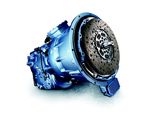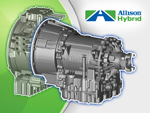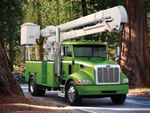Green News
New product introductions played a significant role at The Work Truck Show 2013, produced by NTEA. This year, more than 120 products made their debut at the event, and many fell into the category of green fuel-saving technologies.
The Green Truck Summit, jointly produced by NTEA and CALSTART, was also held in conjunction with The Work Truck Show. The event included a Ride-and-Drive, and attendees were able to visit with exhibitors at the CALSTART Clean Technology and Fuels Pavilion on the show floor. In addition, there were numerous opportunities to learn more about products and programs during a general session on green fleets and in breakout sessions. Topics for the sessions were covered by industry experts and “early adopter” fleet managers who shared their insights, lessons learned and solutions for implementing green technologies.
On its first day, the Green Truck Summit attracted more than 675 attendees. Keynote presenter Lee J. Styslinger III, chairman and CEO of Altec Inc., discussed the future of the green truck industry. Styslinger also reported on Altec’s development of a next generation of hybrid-electric, all-electric and range-extended electric work trucks.
The second day of the Green Truck Summit kicked off with a keynote address by Ron Schoon, executive manager, partnership development at National Renewable Energy Laboratory. Schoon discussed NREL and Clean Cities programs and initiatives, focusing on ongoing outreach to identify the value of clean fuels and technologies in the commercial truck industry. He also shared details about an upcoming national database of duty and drive cycles that all fleets can access to evaluate technologies in real-world applications. Visit www.ntea.com.
Green Truck Association Names 2013 Board of Directors Officers
The Green Truck Association announced its new officers of the board of directors during The Work Truck Show. The affiliate division of NTEA works to improve the efficiency and productivity of work trucks through the development and deployment of strategies to reduce diesel and gasoline consumption and associated environmental impacts.
Elected to one-year terms were:
• Joe Dalum, president and chief executive officer of Odyne Systems LLC, GTA president.
• David Bryant, manager of vocational sales for Freightliner Trucks, GTA vice president.
• Bill Burns, fleet operations manager for the City of Columbus, Ohio, GTA treasurer.
Also now serving on the board for three-year terms are Shawn Brougham, director, marketing and product engineering for Altec Industries, and Rob Stevens, chief nameplate engineer, commercial truck programs for Ford Commercial Truck.
The goal of the GTA is to continue the progression of green work trucks by showcasing green trucks and technology developments, serving as the resource for legislative, regulatory and funding initiatives relevant to green truck development, supplying market data and technical resources relevant to green truck development, and sharing timely news on green truck products and initiatives. Visit www.greentruckassociation.com.
HYBRIDS
Tallahassee Adds Terex HyPower to its Fleet
Terex Utilities has supplied the City of Tallahassee, Fla., with eight new utility trucks equipped with its HyPower Hybrid technology. The sale included four Terex TL41P Hi-Ranger telescopic material-handling aerial devices and four Terex C4045 digger derricks.
According to Buddy Driggers, alternative fuels manager, City of Tallahassee, the city is using its new TL41P HyPower aerial devices as trouble trucks, tasking them to handle everyday utility jobs such as responding to small power outages and removing downed tree limbs from power lines. The Terex C4045 HyPower digger derricks are being used by the city’s line crews.
The new Terex models in the Tallahassee fleet are replacing older utility trucks. In the future and as other units come due for replacement, Driggers noted, the city will evaluate opportunities to add more Terex HyPower trucks to its fleet.
According to Terex, the HyPower Hybrid System significantly reduces fuel consumption, diesel engine exhaust emissions, operating costs and work site noise pollution. The plug-in electric hybrid technology uses stored energy from the system’s rechargeable batteries to power nonpropulsion functions of the vehicle. Operating the utility truck’s boom functions and accessories, the HyPower system can allow crews to work on job sites for hours without starting the engine.
The Terex HyPower Hybrid System can be retrofitted onto existing vehicles. Visit www.terexhypower.com.
Allison Transmission Unveils Fully Automatic Hybrid
Designed for medium- and heavy-duty vehicles, the new Allison H 3000 hybrid-propulsion system is a fully automatic parallel hybrid solution based on the Allison 3000 Series transmission. The H 3000 captures wasted energy during vehicle braking and uses it to assist in propulsion and powering of auxiliary equipment. The design features a torque converter fully automatic transmission and a hybrid motor-generator, power electronics and lithium-ion cell battery packs.
Scalable to each application, the modular lithium-ion battery packs in the H 3000 enable an optimal amount of energy capacity to be tailored to a specific vehicle or duty cycle, Allison noted, allowing for greater flexibility and performance. Depending on vocation and duty cycle, according to the company, the system is designed to offer fuel savings of up to 25 percent.
Production of the H 3000 is expected to begin later this year. Visit www.allisontransmission.com.
Odyne Systems Showcases Walk-In Van Hybrid Power Application
The Odyne Systems plug-in hybrid system that the manufacturer says is capable of reducing diesel fuel consumption up to 50 percent, depending on duty cycles, was recently displayed in a new walk-in van application where it powers climate control and underground tools.
The Odyne plug-in hybrid system interfaces with Allison Transmission’s fully automatic transmissions and uses a Remy electric motor in parallel with the existing drivetrain to provide launch assist and regenerative braking. At the job site, the Odyne hybrid plug-in battery system, featuring Johnson Controls’ lithium-ion battery packs, powers typical applications with the engine off.
Odyne systems are modular and can be applied and retrofitted to a wide range of work truck chassis in various applications. The systems are sold through a distribution network including Altec, DUECO and Terex Utilities. Visit www.odyne.com.
XL Hybrids Expands Product Line
Ford E-Series vans can now be equipped with an XL Hybrids hybrid electric powertrain designed for Class 1 to 3 fleet vehicles. The XL Hybrids technology will initially be available for 2013 model year E-150 and E-250 cargo van and passenger wagon models. The company then plans to release systems for older model year vehicles. The hybrid electric powertrain will be available for retrofit on model year 2013 vans already in fleet service
XL Hybrids also recently announced an installation partnership and distribution agreement with Leggett & Platt Commercial Vehicle Products. Visit www.xlhybrids.com.
Echo Automotive Rolls Out Full-Size Chassis
A 2007 Ford E-250 van with almost 400,000 miles on it was used to demonstrate how the Echo Automotive EchoDrive bolt-on hybrid electric kit for fleet vehicles can be used on multiple model year vehicles within a fleet.
Designed to integrate with existing vehicle architecture, EchoDrive does not replace the existing drivetrain. The system includes a battery, electric motor, inverter and charger that provide additional energy. EchoDrive fits most vehicles with adapter plates and brackets and includes modular battery packs that allow fleets to customize the system. Visit www.echoautomotive.com.
Siemens Moves Hybrid System Production to Georgia
Siemens has brought production of its hybrid traction electric drive systems to its manufacturing plant in Alpharetta, Ga. The move, according to the company, was made to allow for a quicker response to the production and service needs of North American customers.
The company has begun production of inverters, inductors and voltage protection modules at the plant as well as the assembly of electric drive systems within roof rack configurations for transit buses. Visit www.usa.siemens.com/drivetechnologies.
CNG & LPG
Ford Expands CNG-/LPG-Ready Offerings
With sales of Ford vehicles capable of running on CNG or propane autogas reaching record levels, the manufacturer has expanded its line of CNG- and LPG-ready models. Ford will now offer the all-new Ford Transit range of full-size vans, wagons, cutaway and chassis cab models powered by a 3.7-liter V-6 with a CNG/LPG prep kit.
Transit joins the current compact Transit Connect van, wagon and taxi lineup; Ford Super Duty pickups; stripped chassis, E-Series vans, wagons and cutaways; and medium-duty F-450, F-550 and F-650 models being offered with engines prepped for CNG/LPG conversion. In addition, the next generation of the Transit Connect range will add a CNG-ready 2.5-liter four-cylinder engine when it goes on sale later this year.
Each Ford engine that is factory-prepped for gaseous conversion comes equipped with hardened valves and valve seats. Visit http://corporate.ford.com.
Westport Bi-Fuel System Available on Ford Chassis Cab Models
Westport Innovations has announced that its Westport WiNG Power System, a CNG bi-fuel system, is now offered on Ford F-450 and F-550 Super Duty Chassis Cab trucks.
The WiNG Power System is integrated on the 6.8-liter V-10 engine and offers a combined fuel range of approximately 650 miles (at 9 mpg) with maximum CNG capacity (42 gasoline gallon equivalent) and a standard 40-gallon gasoline tank. Once the CNG fuel is depleted, the Super Duty trucks with the Westport system run on conventional gasoline. Visit www.westport.com.
3M and Chesapeake Energy Announce CNG Tank Collaboration
3M has successfully completed the NGV2-2007 certification process for its first CNG tank. The 21.5-x-60-inch tank is designed for light- and medium-duty pickup trucks and corporate fleet vehicles.
The successful certification follows the 2012 announcement by 3M and Chesapeake Energy Corp. that the two companies would collaborate in designing, manufacturing and marketing a broad portfolio of CNG tanks for use in all sectors of the U.S. transportation market.
Chesapeake is slated to become one of the first users of the new 21.5-x-60-inch tank, which it will incorporate in its fleet vehicles. The utility is currently converting its fleet of nearly 5,000 vehicles to run on natural gas. “The fuel tank has been the most expensive single component on a CNG vehicle, causing a bottleneck for the market,” said Nathan Pumphrey, Chesapeake director – fleet operations. “We look forward to incorporating these tanks into our fleet vehicles to save money on our conversions.”
Initially, 3M tanks will be available through five approved upfitters including OEM Systems of Okarche, Okla.; Venchurs Vehicle Systems of Adrian, Mich.; Alternative Fuel Solutions of Mahaffey, Pa.; AVS of Salt Lake City; and World CNG of Kent, Wash. Visit www.3m.com/cng.
Venchurs CNG Announces Collaboration With 3M
Venchurs, a Qualified Vehicle Modifier for Ford Motor Co. with ship-through facilities in Louisville, Ky., and Adrian, Mich., is now utilizing 3M’s newly certified CNG tank.
Companies interested in adding CNG Ford F-250s or F-350s to their fleets are also invited to apply for Venchurs’ short-term loaner program, where they can put the converted trucks to the test. Visit www.venchurscng.com.
ROUSH CleanTech and Green Alternative Systems Unveil New Ford F-550
A Ford F-550 chassis cab powered by propane autogas has been unveiled by ROUSH CleanTech and Green Alternative Systems. The customizable Ford F-550 – for use in passenger vehicles as well as construction, transit and utility applications – is equipped with a 6.8-liter V-10 engine.
Green Alternative Systems, a certified Ford Qualified Vehicle Modifier installer, designs mounting hardware, handles packaging strategy and integrates ROUSH CleanTech propane autogas fuel system technology into the F-550 chassis cab. Visit www.greenalternativesystems.com and www.roushcleantech.com.
DISH Rolls Out Propane-Powered Fleet
Satellite TV company DISH has unveiled the first of 200 ROUSH CleanTech propane autogas-fueled Ford E-250 cargo vans that will enter its fleet in 2013. The company estimates the new propane autogas-powered vehicles will lower carbon dioxide emissions by 12.5 million pounds over the lifetime of the fleet’s operation compared to gas-powered counterparts.
DISH’s new alternative fuel vehicles will support residential and commercial customer service in Atlanta, Chicago, Detroit, Los Angeles and San Francisco. Visit www.roushcleantech.com.
Icom Receives EPA Certifications, Announces Fleet Installation
Icom North America has received 15 new Environmental Protection Agency certifications for its patented JTG II Propane Liquid Injection bi-fuel and dedicated systems. The certifications cover approximately 100 different 2012-2013 General Motors and Ford light-duty trucks and SUV platforms with GM 4.8- and 5.3-liter engines and Ford 3.7-, 4.6- and 5.4-liter engines. Icom’s JTG II system is now available for approximately 600 vehicle platforms.
Icom has also announced an installation program for 140 propane autogas Ford F-150 pickup trucks for use by Menards home improvement stores. The vehicles will serve 36 Menards locations throughout Illinois and at Menards’ Eau Claire West store in Wisconsin. Visit www.icomnorthamerica.com.
HYDROGEN
Fuel Cell-Electric Hybrid Trucks Rolling in Houston
Funding from the Department of Energy and regional stakeholders – including the Houston-Galveston Area Council, Total Transportation Services Inc., Air Products, Vision Industries and the Environmental Defense Fund – is replacing 20 diesel-powered heavy-duty vehicles with zero-emission Tyrano hydrogen fuel cell-electric trucks. The DOE granted HGAC $3.4 million in funding to launch a zero-emission engine technology demonstration project at the Port of Houston Authority where heavy-duty trucks are projected to account for almost half of all port emissions by 2015.
Expected emission reductions from the project include 39 tons of nitrogen oxides and 0.8 tons of particulate matter per year. The trucks are expected to be rolled out later this year and will be fueled with hydrogen locally sourced from natural gas feedstock. Visit www.edf.org.








 Allison
Allison ALTe Powertrain Technologies
ALTe Powertrain Technologies Azure Dynamics
Azure Dynamics Odyne Systems, LLC
Odyne Systems, LLC  Quantum Fuel Systems Technologies Worldwide Inc.
Quantum Fuel Systems Technologies Worldwide Inc.

